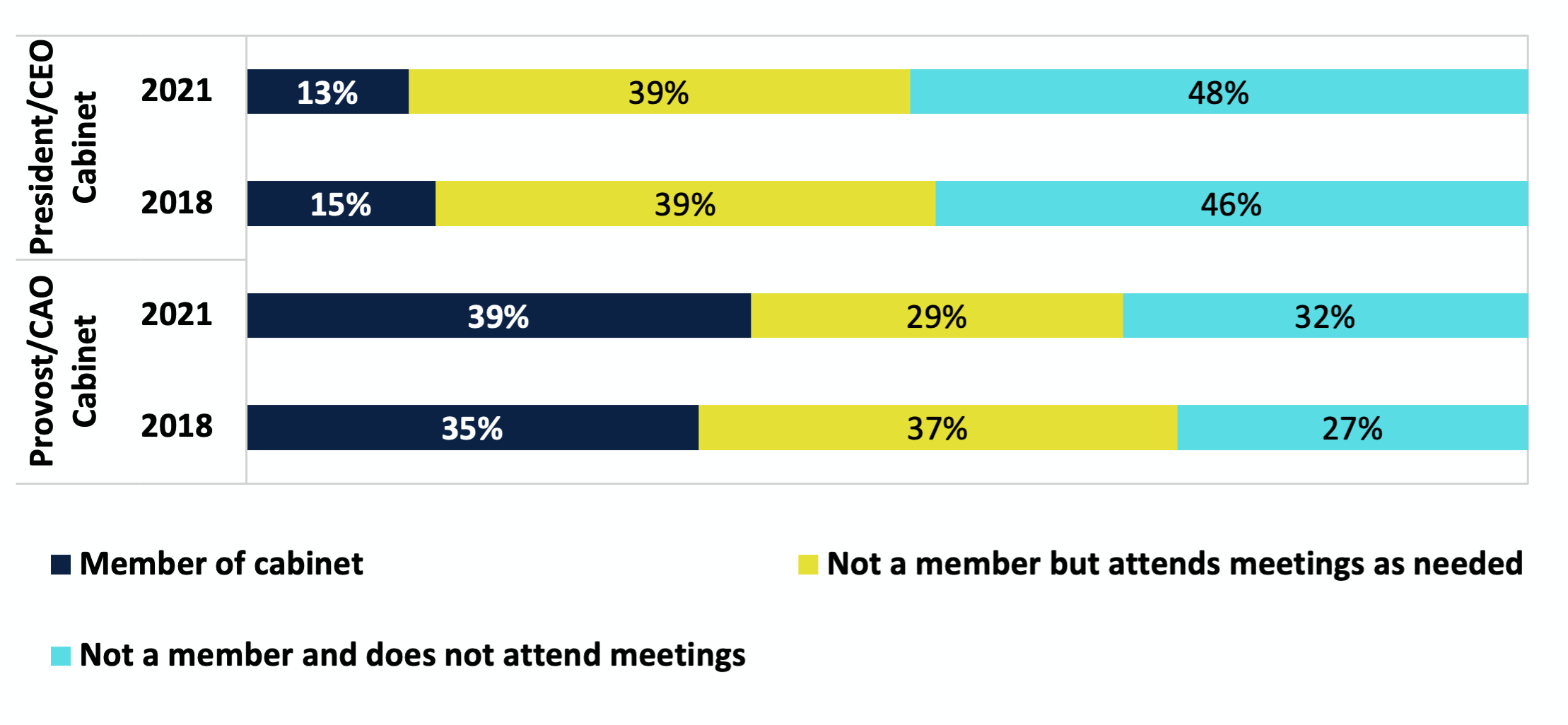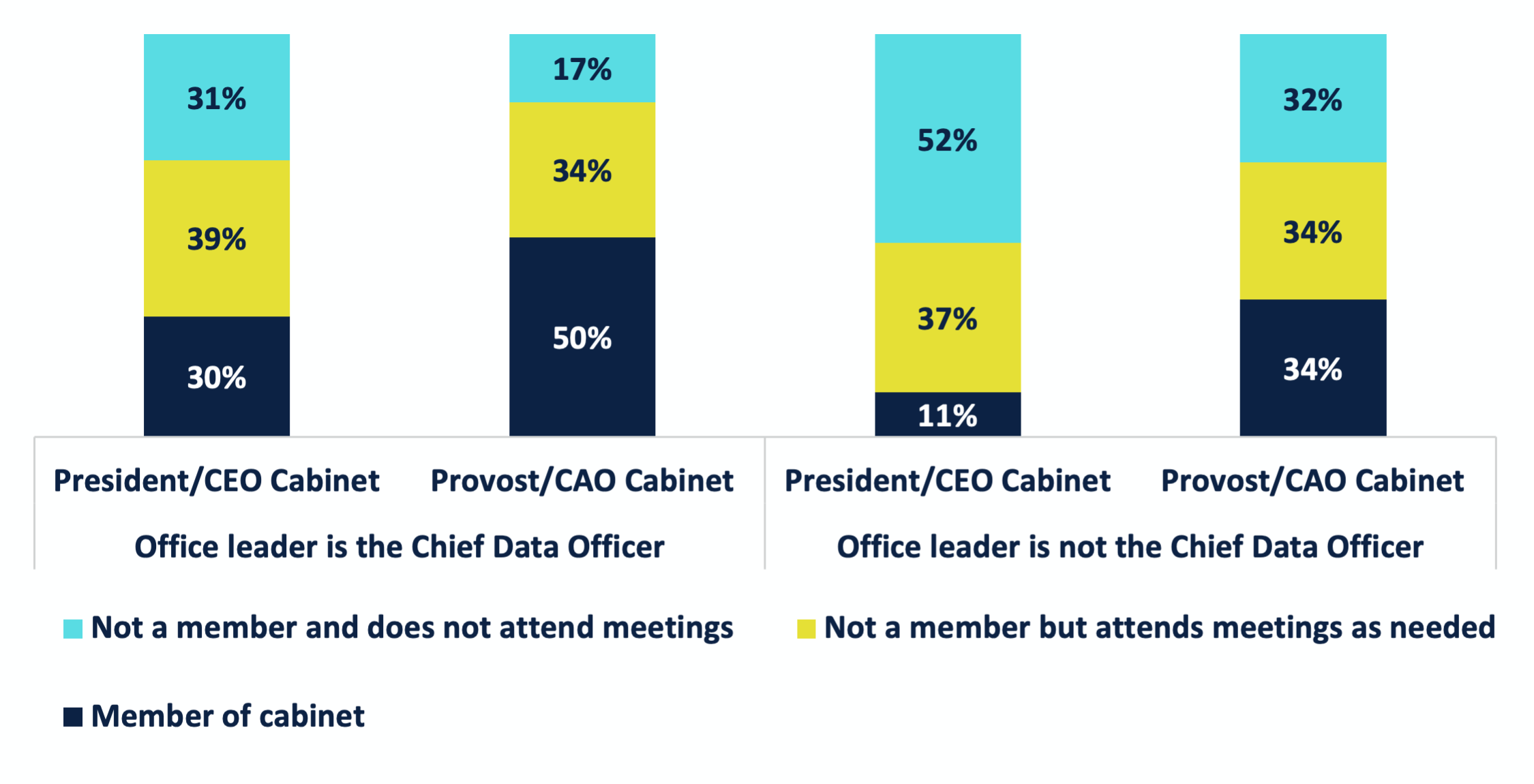Executive Leadership for the Data and Analytics Function
This brief is one of a series of reports. Learn more at airweb.org/nationalsurvey.
The AIR Statement of Aspirational Practice for Institutional Research (2016) and A New Vision for Institutional Research (Change magazine, 2016) call for executive leadership of the data and analytics function, such as a chief data officer (CDO). We included questions in the 2021 AIR National Survey of IR Offices to explore how institutions are answering the call, what proportion of institutional research (IR) office leaders fill the CDO role (or similar), and how serving in the CDO position (or similar) influences IR office leaders’ evaluations of institutional data capacity.
Chief Data Officer
Of the 520 institutions that responded to the 2021 AIR National Survey, fewer than half have CDO positions (Table 1). This varies across the major institutional sectors: public 4-year, public 2-year, and private not-for-profit 4-year. More public 2-year institutions have this position than 4-year institutions (public or not-for-profit).
Nearly three-fourths of institutional CDO positions are filled by IR office leaders. Office leaders at public 4-year institutions are slightly more likely to hold that position than office leaders in the other two sectors.
| All Institutions | Public 4-year | Public 2-year | Private NFP 4-year | |
| % Institutions with CDO Position | 42% | 38% | 48% | 43% |
| Of those, % of IR Office Leaders serving as CDO | 74% | 79% | 76% | 65% |
Of the IR offices that responded to the 2018 and 2021 AIR National Surveys, 252 provided information about the CDO position. While the percentage of institutions with the CDO position increased slightly between the surveys, the percentage of those
positions held by IR office leaders dropped (Table 2).
| 2021 | 2018 | |
|---|---|---|
| % Institutions with CDO Position | 42% | 41% |
| Of those, % of IR Office Leaders serving as CDO | 75% | 84% |
Executive Cabinets
We asked IR office leaders about their relationships with their institutions’ executive cabinets. We learned that less than 20% of office leaders are members of president/chief executive officer (CEO) cabinets while 40% are members of provost/chief academic officer (CAO) cabinets (Table 3).
These numbers vary by sector. For example, office leaders at public 2-year institutions are more likely to be members of the president/CEO cabinet compared to colleagues at 4-year institutions.
| All Institutions | Public 4-year | Public 2-year | Private NFP 4-year | |
|---|---|---|---|---|
| President/CEO Cabinet | ||||
| Member of cabinet | 17% | 10% | 37% | 12% |
| Not a member but attends meetings as needed | 38% | 40% | 37% | 37% |
| Not a member and does not attend meetings | 45% | 50% | 26% | 51% |
| Provost/CAO Cabinet | ||||
| Member of cabinet | 40% | 44% | 38% | 37% |
| Not a member but attends meetings as needed | 33% | 33% | 42% | 30% |
| Not a member and does not attend meetings | 27% | 23% | 20% | 33% |
Of the IR offices that responded to the 2018 and 2021 AIR National Surveys, 253 provided information about executive cabinet relationships. Chart 1 shows that when compared to 2018, fewer office leaders in 2021 are members of their institutions’
president/CEO cabinets while more office leaders are members of their institutions’ provost/CAO committees. Also, the percentage of office leaders who are not members of CEO or CAO cabinets and do not attend meetings increased between 2018 and
2021.
Chart 1. Longitudinal Comparison of Office Leaders' Relationship with Executive Cabinets

We found that IR office leaders who also serve as their institutions’ CDOs are more likely to be members of the executive cabinets, or attend meetings as needed, compared to those who do not serve as CDOs (Chart 2).
Chart 2. Relationship between IR Office Leaders, CDO Status, and Executive Cabinets

References
Swing, R. L., & Ross, L. E. (2016). Statement of aspirational practice for institutional research. Tallahassee, FL: AIR. http://www.airweb.org/aspirationalstatement
Swing, R. L., & Ross, L. E. (2016, March/April). A new vision for institutional research. Change: The Magazine of Higher Learning, 6-13. https://www.airweb.org/resources/publications/studies-and-reports/a-new-vision-for-institutional-research
Methodology
The 2021 AIR National Survey of IR Offices attempted to survey IR office leaders at more than 3,000 postsecondary degree-granting institutions. Institutions of all sectors, types of control, and sizes were included in the sample. In total, responses were collected from 1,142 institutions, and 554 of those institutions completed the survey in full. To ensure comparable results, incomplete responses are excluded from this report. In addition, responses from for-profit institutions, administrative units, international institutions, private not-for-profit 2-year institutions, and institutions in U.S. territories are excluded due to low response rates.
The findings presented in this report are based on 520 responses that represent U.S. postsecondary, degree-granting institutions at public 4-year (146 institutions), public 2-year (125 institutions), or private not-for-profit 4-year institutions (249 institutions).
Suggested Citation
Jones, D., Keller, C., & Raza, Z., (2022). 2021 AIR National Survey of IR Offices: Executive Leadership for the Data and Analytics Function [Report]. Association for Institutional Research. www.airweb.org/NationalSurvey.
Related Content
2021 AIR National Survey of IR Offices: Topic Briefs
AIR National Survey of IR Offices
Long Description
Chart 1. Longitudinal Comparison of Office Leaders' Relationship with Executive Cabinets
Chart 1 is a bar chart displaying a longitudinal comparison of office leaders' relationship with executive cabinets. The chart is divided into two sections: Provost/CAO Cabinet and President/CEO Cabinet. Numerical values presented on the image:
| Relationship | 2018 | 2021 |
|---|---|---|
| Member of cabinet | 35% | 39% |
| Not a member but attends meetings as needed | 37% | 29% |
| Not a member and does not attend meetings | 27% | 32% |
| Relationship | 2018 | 2021 |
|---|---|---|
| Member of cabinet | 15% | 13% |
| Not a member but attends meetings as needed | 39% | 39% |
| Not a member and does not attend meetings | 46% | 48% |
Chart 2. Relationship between IR Office Leaders, CDO Status, and Executive Cabinets
Chart 2 is a bar chart divided into two sections: Office leader is the Chief Data Officer and Office leader is not the Chief Data Officer.
| Relationship | President/CEO Cabinet | Provost/CAO Cabinet |
|---|---|---|
| Member of cabinet | 30% | 50% |
| Not a member but attends meetings as needed | 39% | 34% |
| Not a member and does not attend meetings | 31% | 17% |
| Relationship | President/CEO Cabinet | Provost/CAO Cabinet |
|---|---|---|
| Member of cabinet | 11% | 34% |
| Not a member but attends meetings as needed | 37% | 34% |
| Not a member and does not attend meetings | 52% | 32% |
